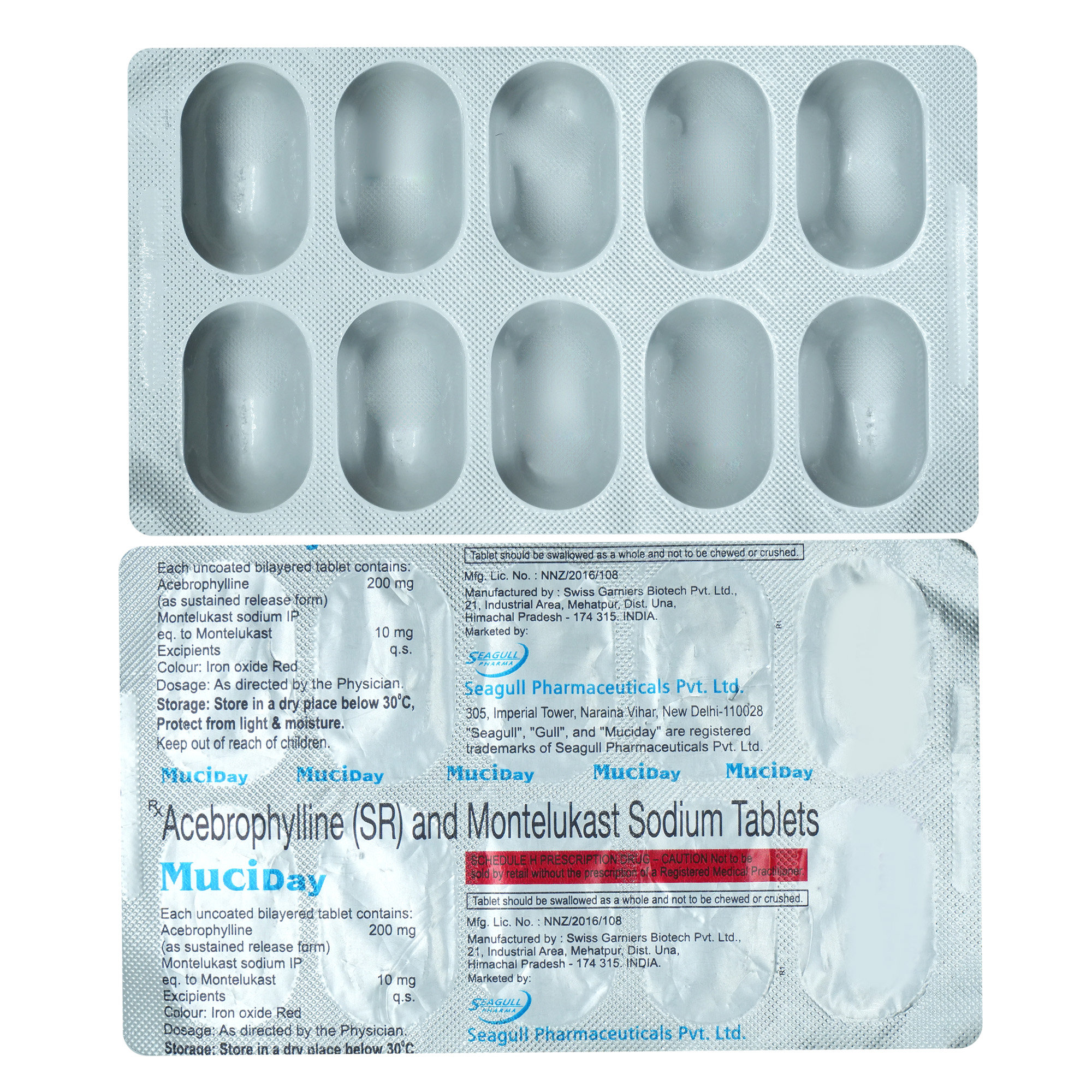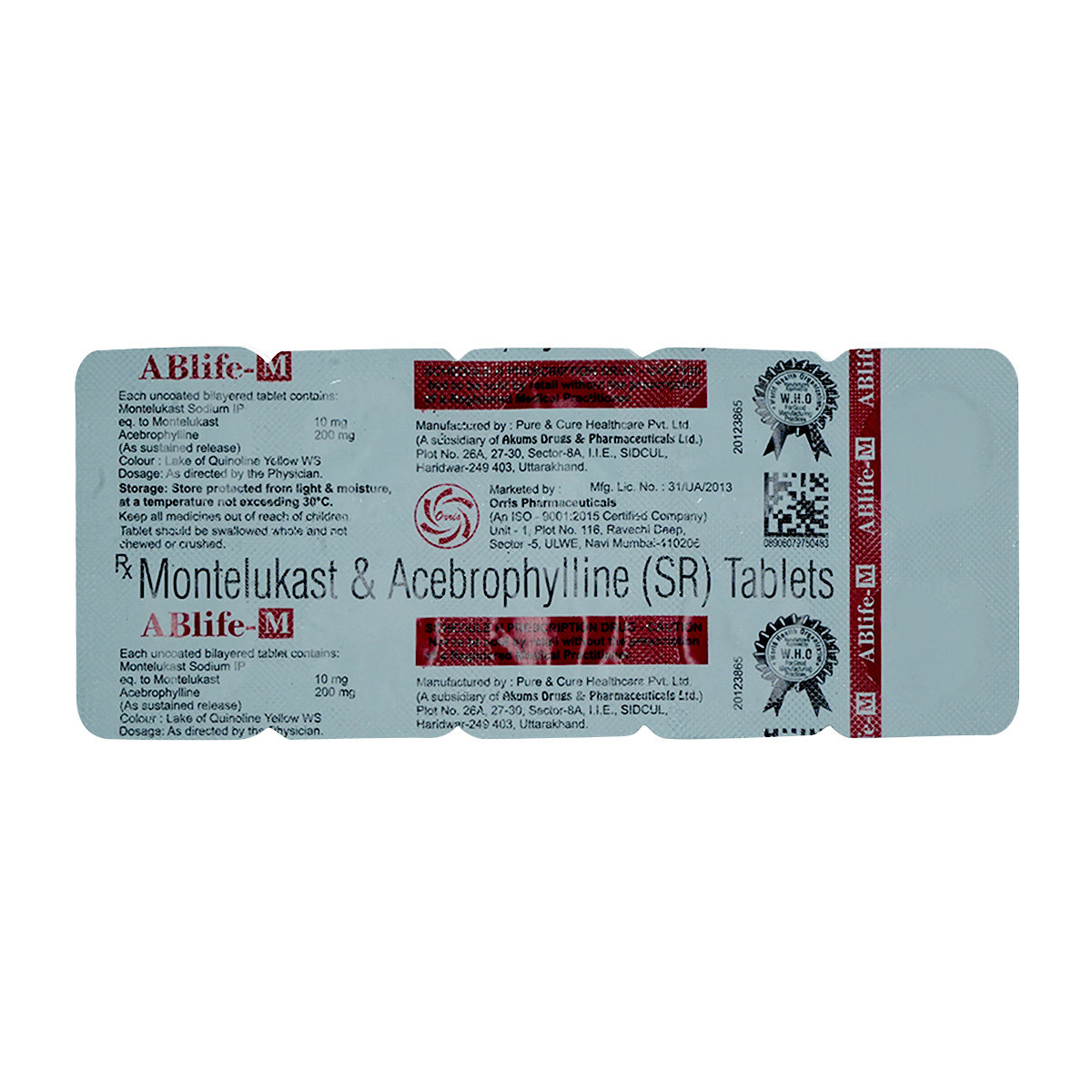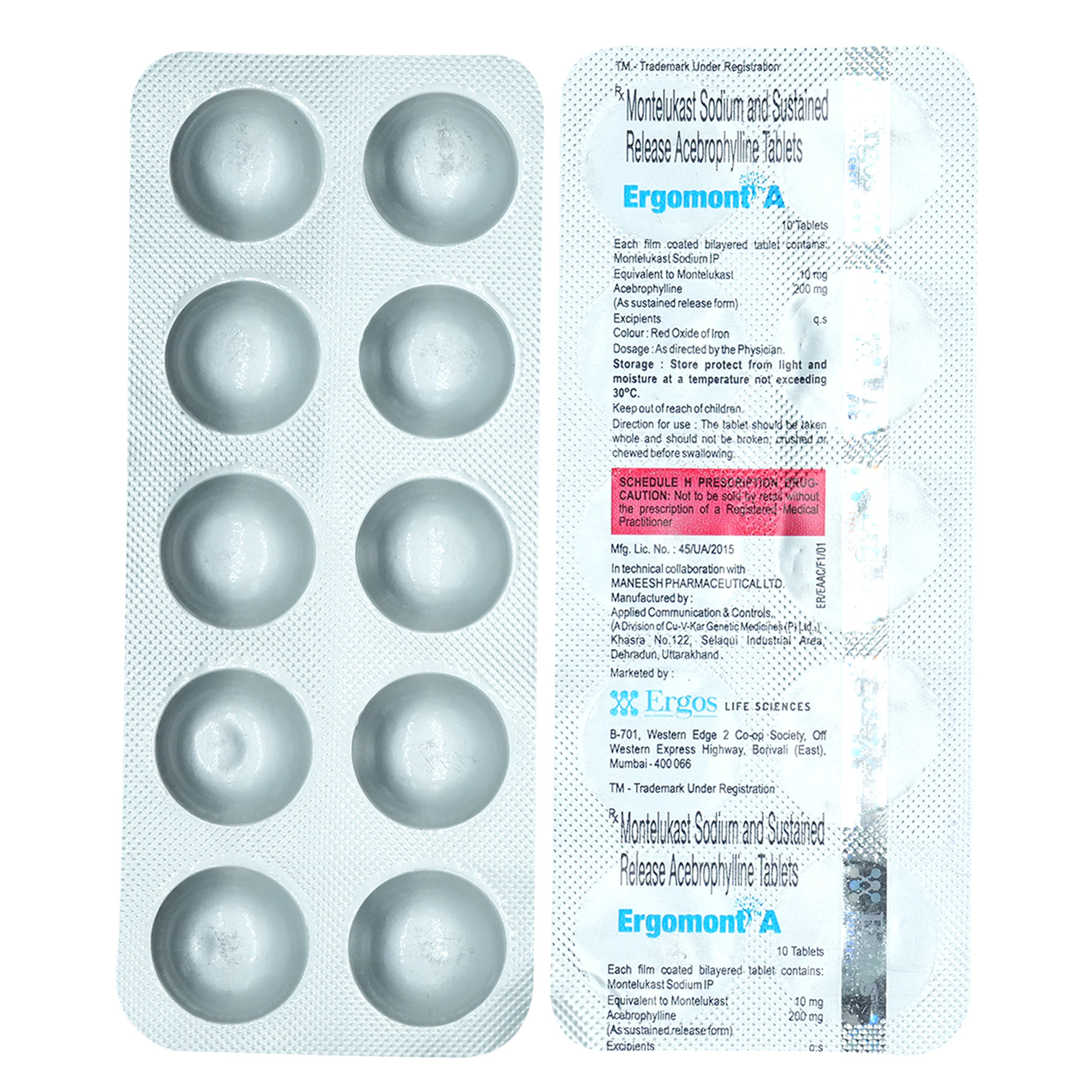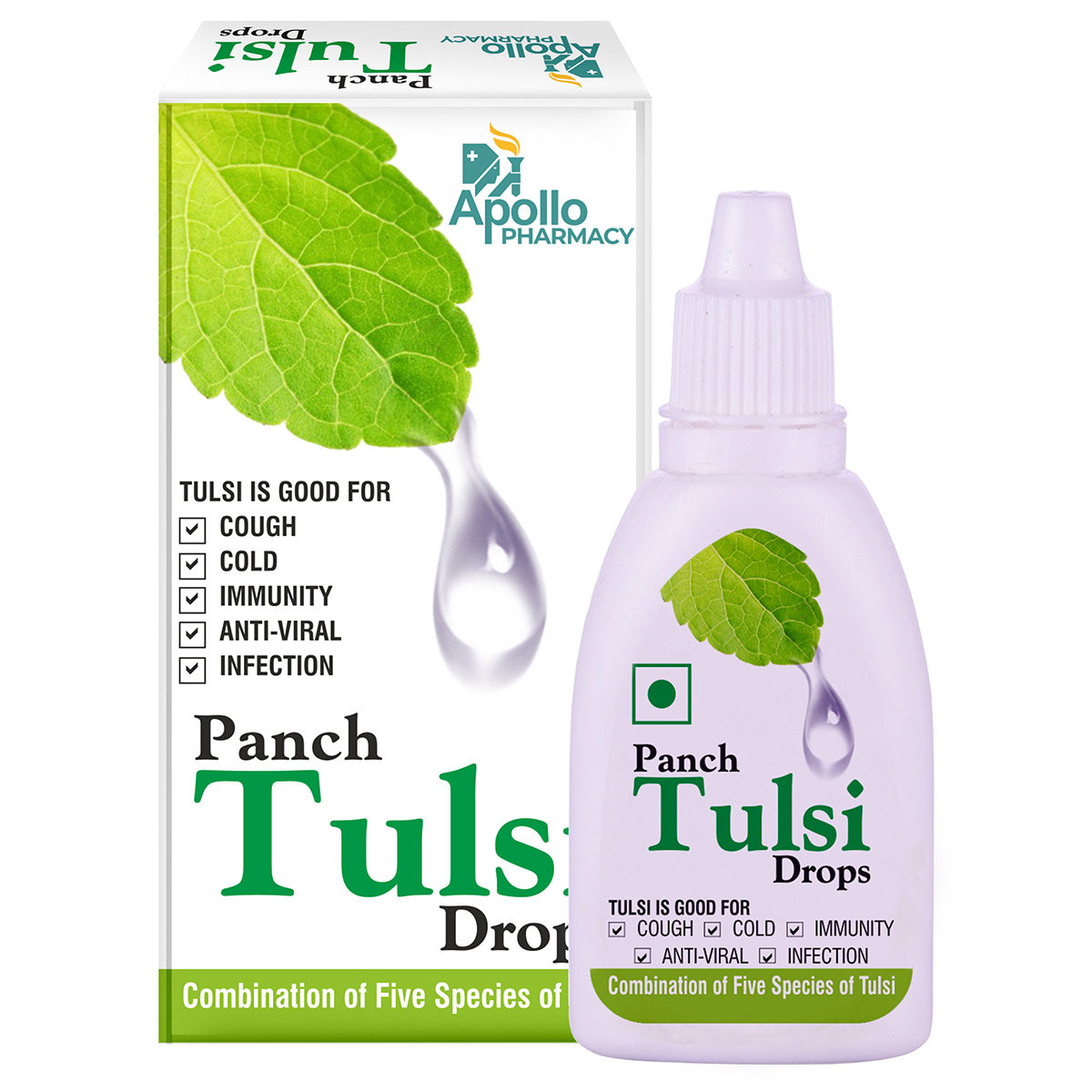Glemont A Tablet 10's
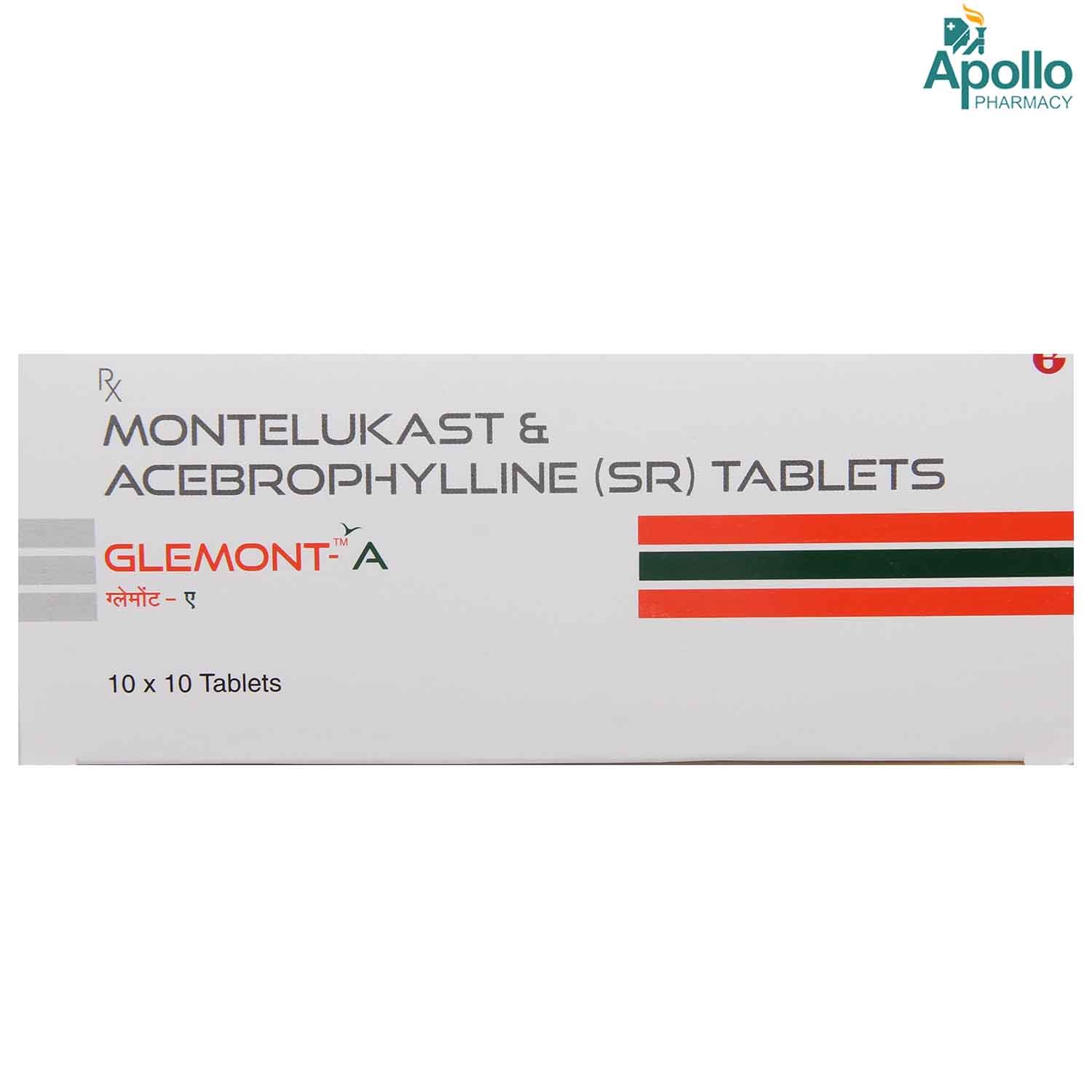
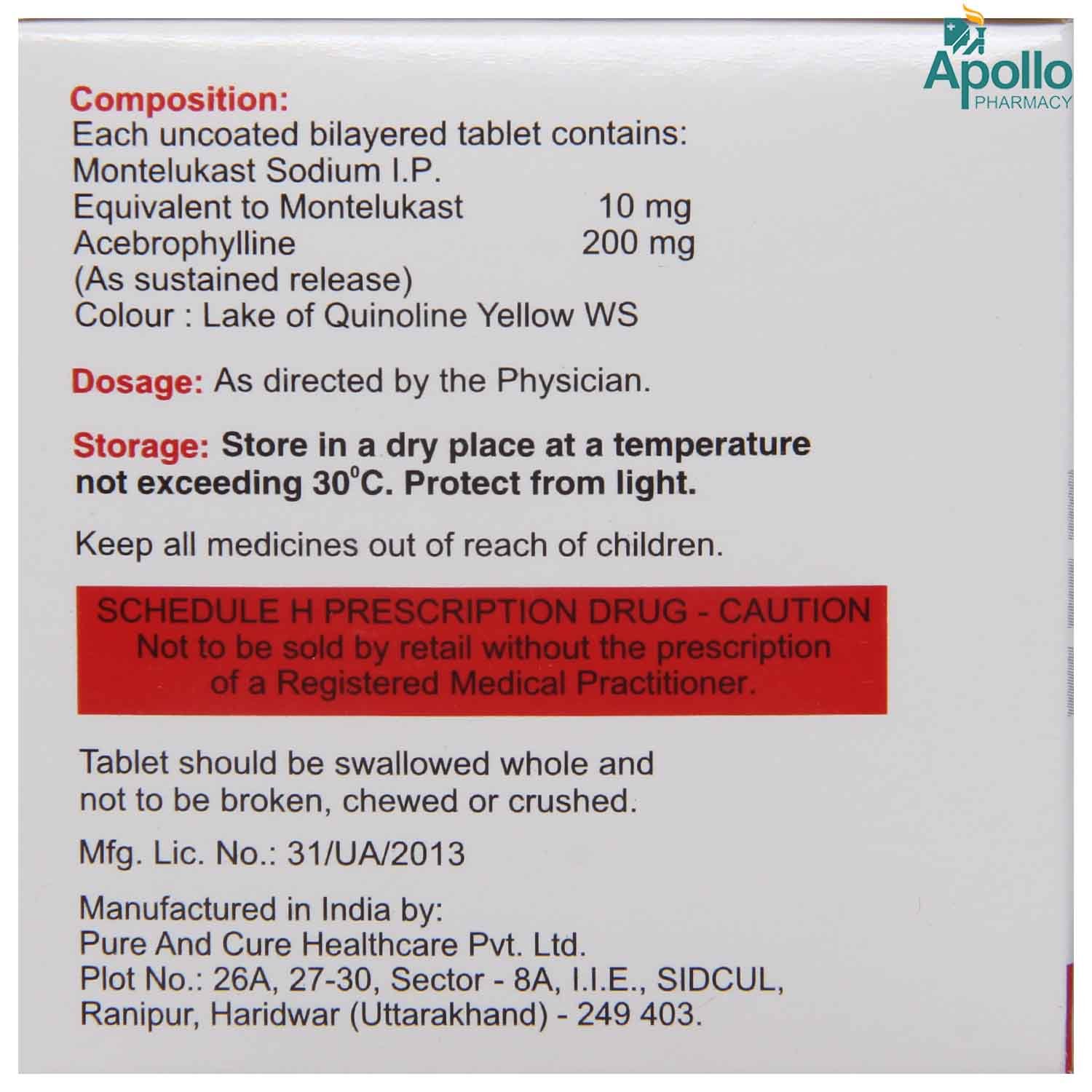
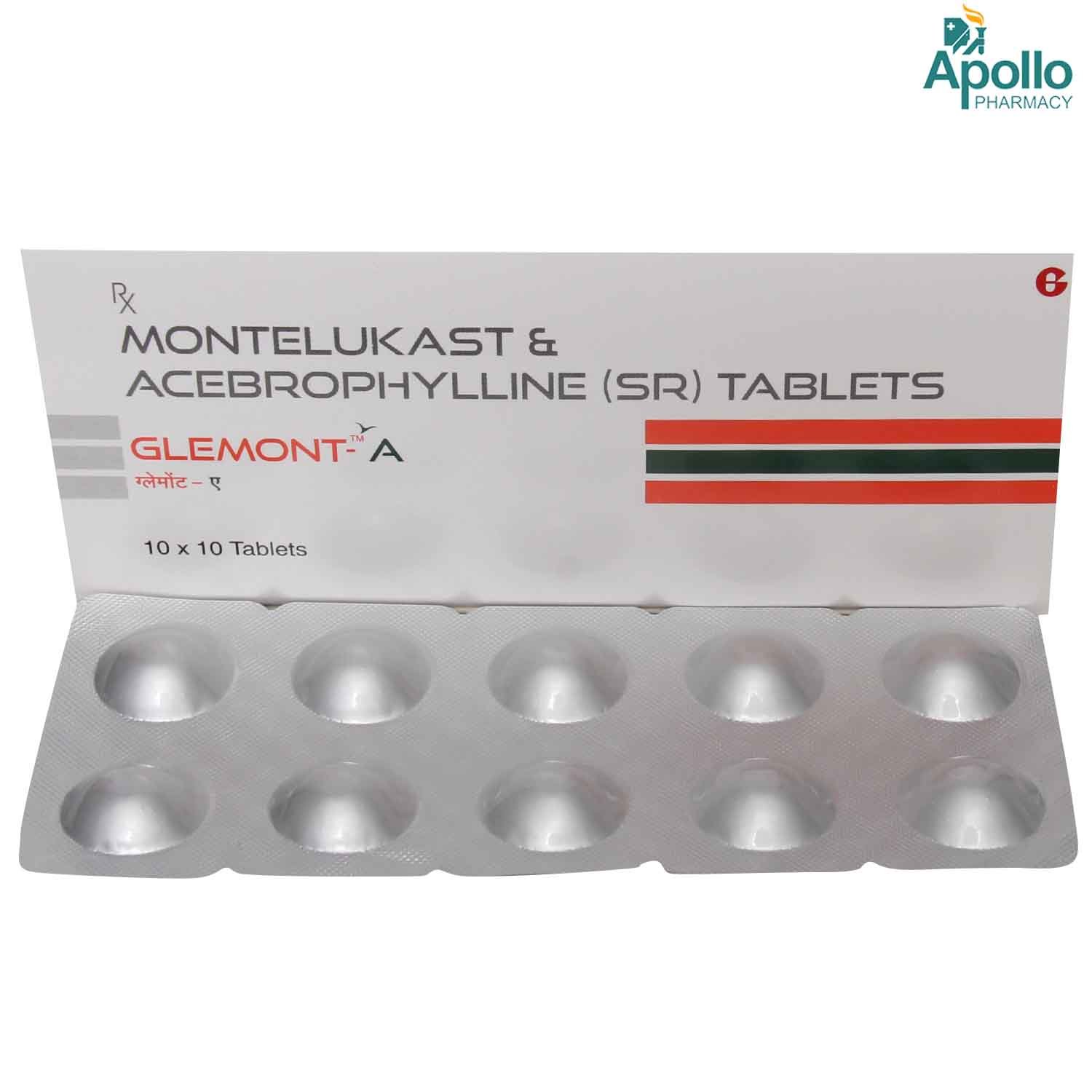
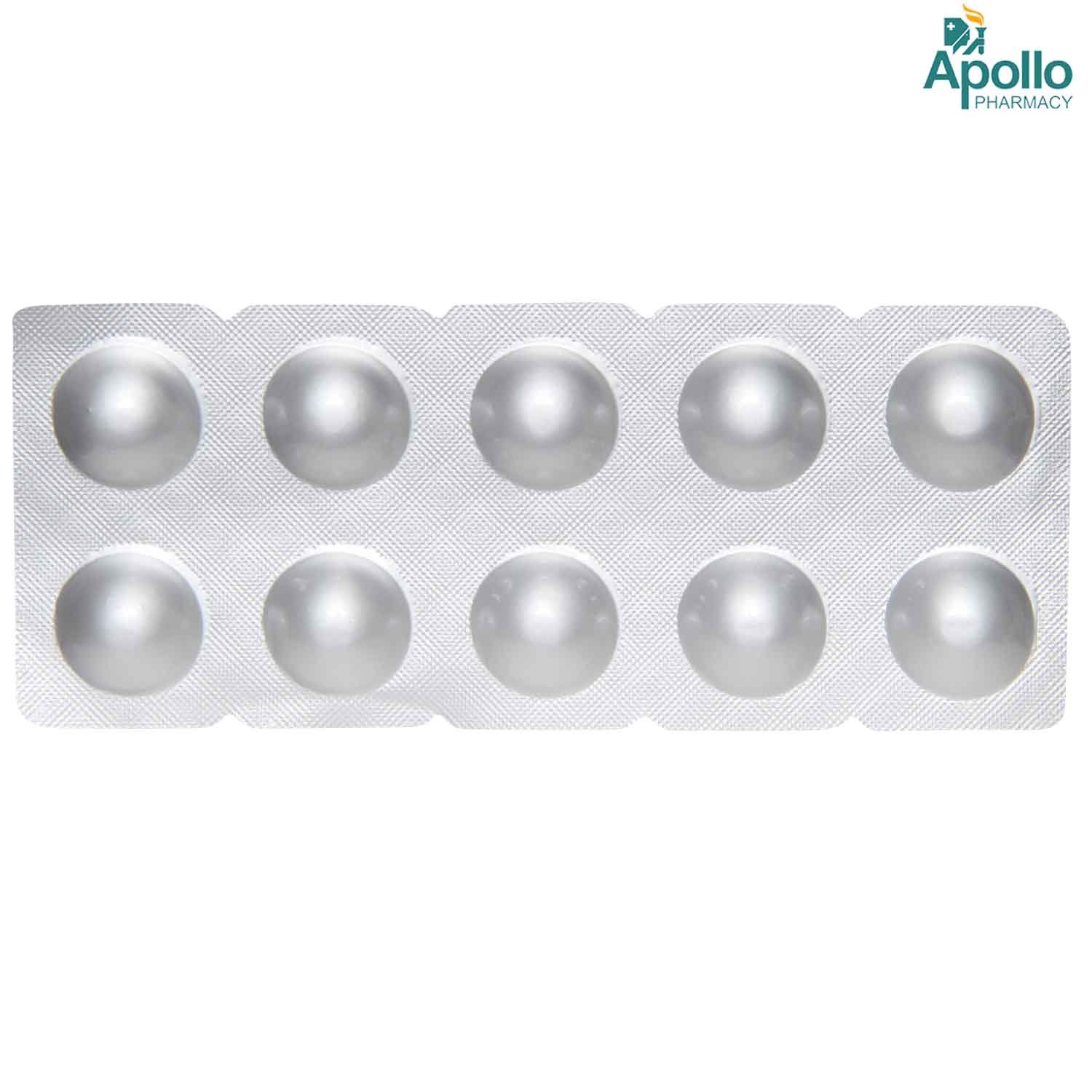
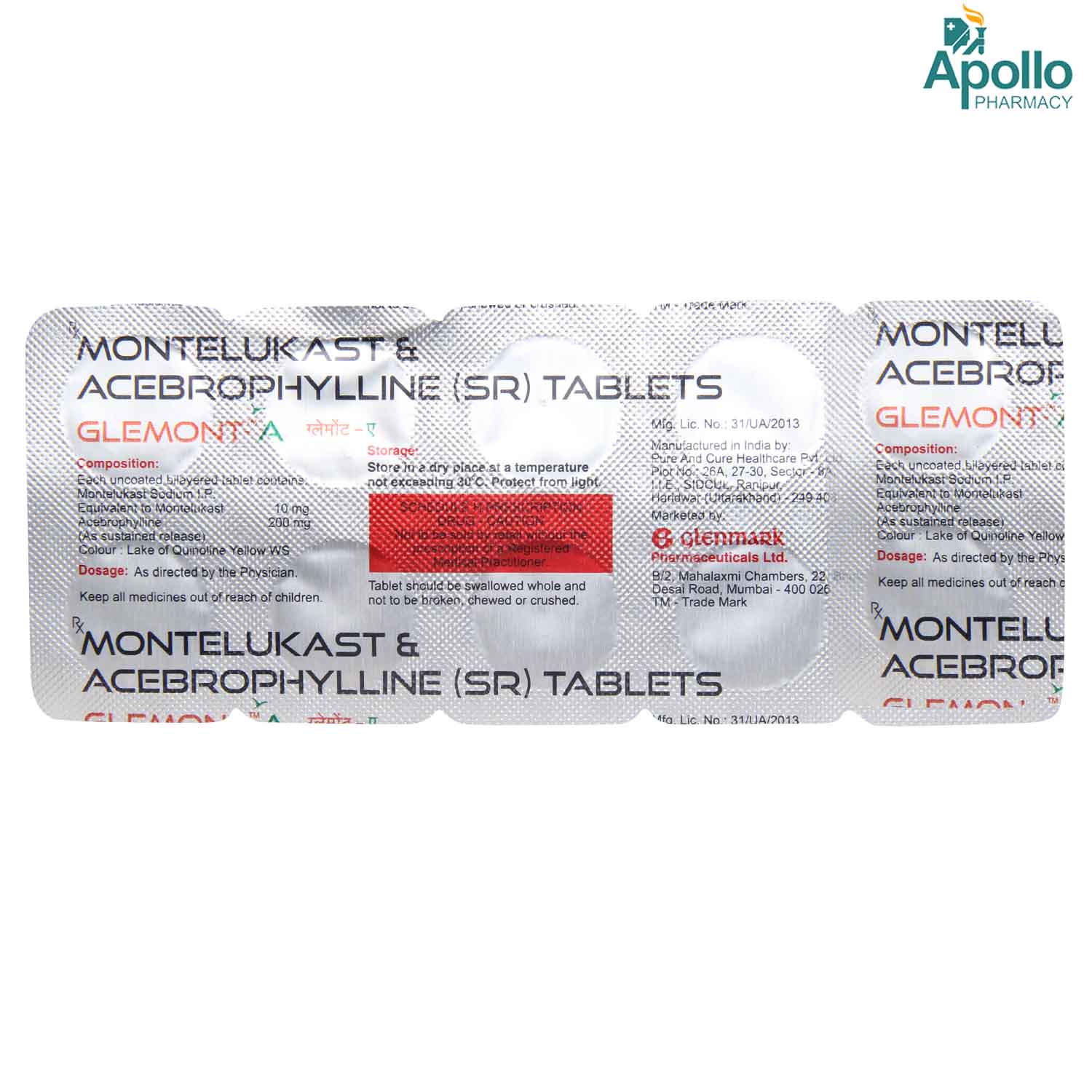
MRP ₹280
(Inclusive of all Taxes)
₹42.0 Cashback (15%)
Glemont A Tablet is used to treat and prevent respiratory disorders like asthma attacks, chronic obstructive pulmonary diseases (COPD) and allergic rhinitis (hay fever). It contains Acebrophylline and Montelukast, which work by relaxing muscles and widening the airways of the lungs.
It may cause common side effects such as headache, sore throat/cough, vomiting, upset stomach, diarrhea, heartburn, runny nose, rash, itching, drowsiness, restlessness, abdominal pain (stomach pain), and nasal inflammation. Before taking this medicine, you should tell your doctor if you are allergic to any of its components or if you are pregnant/breastfeeding, and about all the medications you are taking and pre-existing medical conditions.
Know Your Delivery Time
Provide Delivery Location

Secure Payment

India's Most Trusted Pharmacy

Genuine Products
Composition :
Manufacturer/Marketer :
Consume Type :
Return Policy :
Expires on or after :
About Glemont A Tablet
Glemont A Tablet is primarily used to treat and prevent respiratory disorders like asthma attacks, chronic obstructive pulmonary diseases (COPD) and allergic rhinitis (hay fever). Asthma is a condition in which the airways narrow and swell, leading to difficulty breathing. COPD is a group of lung diseases which includes emphysema (shortness of breath) and chronic bronchitis (inflammation of the lining of your bronchial tubes).
Glemont A Tablet is a combination of Acebrophylline and Montelukast. Acebrophylline works by relaxing muscles and widening the airways of the lungs. Montelukast blocks the leukotrienes (chemicals), thereby reducing inflammation and swelling in the nose.
The common side effects of Glemont A Tablet include headache, sore throat/cough, vomiting, upset stomach, diarrhoea, heartburn, runny nose, rash, itching, drowsiness, restlessness, abdominal pain, and nasal inflammation. Most of these side effects do not require medical attention. However, if the side effects persist, please contact your doctor.
Your doctor will advise the dose and duration of the course based on the severity of your disease. Glemont A Tablet can be taken with or without food as advised by your doctor. Do not chew, crush, or break it.
Inform your doctor if you are allergic to any of its components. Glemont A Tablet is not intended for use during an acute asthma attack. Your doctor may suggest other medications for your sudden asthma attack. It is advisable to check with your doctor if you are pregnant, currently breastfeeding, or taking any other prescribed or non-prescribed medicines before starting Glemont A Tablet .
Uses of Glemont A Tablet
Glemont A Tablet is used in the treatment and prevention of asthma and chronic obstructive pulmonary disease (COPD). The detailed uses of Glemont A Tablet are as follows:
- Manages Asthma: Glemont A Tablet helps prevent and control asthma symptoms such as wheezing, shortness of breath, coughing, and chest tightness by relaxing the airway muscles and widening the air passages in the lungs.
- Manages COPD: Glemont A Tablet is used to manage COPD, including emphysema and chronic bronchitis. It helps relieve airflow obstruction in the lungs by relaxing muscles and reducing airway inflammation.
- Prevents Exercise-Induced Bronchospasm: Glemont A Tablet helps prevent breathing difficulties caused by sudden tightening of airway muscles (bronchospasm) during physical activity, especially in asthma patients.
- Manages Allergic Rhinitis: Glemont A Tablet may help relieve symptoms of allergic rhinitis, such as sneezing, itching, runny nose, and nasal congestion, by blocking the action of leukotrienes, chemicals responsible for inflammation in the nasal passages.

Have a query?
Directions for Use
- Glemont A Tablet can be taken with or without food as advised by your doctor.
- Follow your doctor's instructions on the dosage and timing of this medication to ensure safety.
- Swallow Glemont A Tablet as a whole with a glass of water.
- Do not chew, crush, or break it.
Medicinal Benefits
- Glemont A Tablet contains Acebrophylline and Montelukast.
- Acebrophylline is a bronchodilator that works by relaxing muscles and widening the airways of the lungs.
- Acebrophylline also has muco-regulating/mucolytic (dissolves thick mucus and helps relieve breathing difficulties) and anti-inflammatory properties.
- Montelukast blocks leukotrienes (chemicals released in response when a body comes in contact with an allergen) and reduces inflammation and swelling in the nose.
- It also inhibits bronchoconstriction (narrowing of airways in the lungs that lead to breathing difficulties).
- Montelukast is also used to relieve exercise-induced bronchospasm (shortness of breath that occurs only during exercise).
- Glemont A Tablet dissolves thick mucus and helps relieve breathing difficulties.
How Glemont A Tablet Works
Storage
- Hydrate your body: Drink enough water to prevent dehydration and headaches.
- Calm Your Mind: Deep breathing and meditation can help you relax and relieve stress.
- Rest and Recharge: Sleep for 7-8 hours to reduce headache triggers.
- Take rest: lie down in a quiet, dark environment.
- Cold or warm compresses can help reduce tension.
- Stay Upright: Maintain good posture to keep symptoms from getting worse.
- To treat headaches naturally, try acupuncture or massage therapy.
- Over-the-counter pain relievers include acetaminophen and ibuprofen.
- Prescription Assistance: Speak with your doctor about more substantial drug alternatives.
- Severe Headaches: Seek emergency medical assistance for sudden, severe headaches.
- Frequent Headaches: If you get reoccurring headaches, consult your doctor.
- Headaches with Symptoms: Seek medical attention if your headaches include fever, disorientation, or weakness.
- Inform your doctor about dizziness symptoms. They may adjust your medication regimen or prescribe additional medications to manage symptoms.
- Follow your doctor's instructions for taking medication, and take it at the same time every day to minimize dizziness.
- When standing up, do so slowly and carefully to avoid sudden dizziness.
- Avoid making sudden movements, such as turning or bending quickly, which can exacerbate dizziness.
- Drink plenty of water throughout the day to stay hydrated and help alleviate dizziness symptoms.
- If you're feeling dizzy, sit or lie down and rest until the dizziness passes.
- Track when dizziness occurs and any factors that may trigger it, and share this information with your doctor to help manage symptoms.
- Drink water or other clear fluids.
- To prevent worsening of pain, limit intake of tea, coffee, or alcohol.
- Include bland foods like rice, toast, crackers, and rice in your diet.
- Avoid lying down immediately after eating as it may cause indigestion or heartburn.
- Avoid acidic and spicy food as it may cause indigestion.
- Take medications with food (if recommended): It can help prevent stomach distress and indigestion.
- Eat smaller, more frequent meals: Divide daily food intake into smaller, more frequent meals to ease digestion.
- Avoid trigger foods: Identify and avoid foods that trigger indigestion, such as spicy, fatty, or acidic foods.
- Stay upright after eating: Sit or stand upright for at least 1-2 hours after eating to prevent stomach acid from flowing into the oesophagus.
- Avoid carbonated drinks: Avoid drinking carbonated beverages, such as soda or beer, which can worsen indigestion.
- Manage stress: To alleviate indigestion, engage in stress-reducing activities like deep breathing exercises or meditation.
- Consult a doctor if needed: If indigestion worsens or persists, consult a healthcare professional to adjust the medication regimen or explore alternative treatments.
- To improve liver health and aid in the removal of toxins, drink lots of water.
- Alcohol consumption should be reduced or stopped because it can raise ALT levels and impair liver function.
- Consume a well-rounded diet full of whole grains, fruits, and vegetables. Limit items that strain the liver, such as processed, fatty, or fried foods.
- You can monitor your ALT levels and make treatment modifications with the support of routine blood tests.
- Consume more fruits, vegetables, and cruciferous foods like cabbage, kale, and broccoli.
- Reduced alcohol intake can enhance liver enzyme function.
- Oxidative stress can be managed by eating foods rich in antioxidants, such as vitamins C and E.
- Liver function tests regularly can help manage increased levels of AST.
- Rest well; get enough sleep.
- Eat a balanced diet and drink enough water.
- Manage stress with yoga and meditation.
- Limit alcohol and caffeine.
- Physical activities like walking or jogging might help boost energy and make you feel less tired.
What if I have taken an overdose of Glemont A Tablet
Drug Warnings
- Do not stop taking this medicine of your own unless advised by your doctor.
- Before taking Glemont A Tablet , let your doctor know if you have heart, liver, kidney and lung diseases, neuropsychiatric disorders like seizures (fits) and depression, phenylketonuria (birth defect caused by the build-up of an amino acid called phenylalanine in the body), hyperthyroidism (overactive thyroid), high blood pressure, stomach ulcers and viral infections.
- Glemont A Tablet is not intended for use during an acute asthma attack.
- Therapy with medicines like Montelukast should be cautiously administered in patients with neuropsychiatric disorders.
- Please seek medical advice if you are pregnant, currently breastfeeding, or taking any other prescribed or non-prescribed medicines before starting Glemont A Tablet .
Drug-Drug Interactions
Drug-Drug Interactions
Login/Sign Up
Coadministration of Miconazole with Glemont A Tablet may increase the blood levels and effects of Glemont A Tablet. This increases the risk or severity of side effects.
How to manage the interaction:
Although there is a possible interaction between miconazole and Glemont A Tablet, you can take these medicines together if prescribed by your doctor. However, if you experience any symptoms such as fever, sore throat, cough, stomach pain, diarrhea, earache, runny nose, or uncommon, depression, confusion, difficulty concentrating, anxiety, hallucinations, irritability. memory impairment, restlessness, sleep walking, Consult a doctor immediately. Do not stop using medications without a doctor's advice.
Coadministration of Glemont A Tablet and rifabutin can reduce the levels and effects of Rifabutin. This can lead to low treatment outcomes.
How to manage the interaction:
Taking Glemont A Tablet and rifabutin together can possibly result in an interaction, it can be taken if your doctor has advised it. However, if you experience increased side effects such as headache, fever, sore throat, cough, abdominal pain, diarrhea, earache, runny nose, or behavior and mood changes consult a doctor. Do not discontinue any medications without consulting a doctor.
Coadministration of Rifapentine with Glemont A Tablet may reduce the blood levels and effects of Glemont A Tablet. This can lead to low treatment outcomes.
How to manage the interaction:
Taking Rifapentine with Glemont A Tablet together can possibly result in an interaction, it can be taken if your doctor has advised it. If you experience increased side effects such as headache, fever, sore throat, cough, abdominal pain, diarrhea, earaches, runny nose, or behavior and mood changes consult a doctor. Do not discontinue any medications without consulting a doctor.
Coadministration of Glemont A Tablet and Phenytoin may reduce the blood levels and effects of Glemont A Tablet. This can lead to low treatment outcomes.
How to manage the interaction:
Taking Glemont A Tablet and Phenytoin may interact with one another, but they can be taken together if your doctor has prescribed them. However, if you experience signs such as headache, fever, sore throat, cough, abdominal pain, diarrhoea, earache, runny nose, or behaviour and mood changes, consult a doctor immediately. Do not discontinue any medications without consulting a doctor.
Coadministration of Glemont A Tablet and primidone can reduce the levels and effects of Glemont A Tablet.
How to manage the interaction:
Taking Glemont A Tablet and Primidone together can possibly result in an interaction, it can be taken if prescribed by a doctor. However, if you experience any unusual symptoms, contact a doctor immediately. Do not discontinue any medications without consulting a doctor.
Drug-Food Interactions
Drug-Food Interactions
Login/Sign Up
Diet & Lifestyle Advise
- Add ginger to foods or tea as it contains some anti-inflammatory compounds that can relax membranes in the airways and reduce cough, irritation, and swelling in the nasal passages.
- Eat foods rich in potassium, such as tomatoes, bananas, asparagus, oranges, potatoes, avocados, dark leafy greens, and beetroot, as potassium is important for lung function and potassium deficiency may cause breathing problems.
- Staying hydrated is vital for those with a cough or cold. Drink liquids at room temperature to get relief from runny nose, cough, and sneezing.
- Do meditation, deep breathing, regular exercise, and try progressive muscle relaxation techniques to get relief from stress.
- Quit smoking as it may reduce the effectiveness of the Glemont A Tablet and irritate the lungs, worsening breathing problems.
- It is advised to avoid contact with known allergens (allergy-causing agents), such as pollen, dust, etc. Also, certain food items are known to cause allergies to you.
- Maintain personal hygiene and keep your surroundings clean.
Habit Forming
Therapeutic Class
All Substitutes & Brand Comparisons
RX
Muciday Tablet 10's
Seagull Pharmaceutical Pvt Ltd
₹147
(₹13.23 per unit)
47% CHEAPERRX
Ablife M 10/200 Tablet 10's
Orris Pharmaceuticals
₹154.5
(₹13.91 per unit)
44% CHEAPERRX
Ergomont A Tablet 10's
Ergos Life Sciences Pvt Ltd
₹174
(₹15.66 per unit)
37% CHEAPER
Alcohol
Unsafe
Avoid drinking alcohol while taking Glemont A Tablet to avail the maximum benefits and prevent the worsening of side-effects.
Pregnancy
Consult your doctor
Glemont A Tablet is recommended to use with caution and under doctor's supervision during pregnancy. Please consult your doctor if you are planning to conceive or already pregnant before starting Glemont A Tablet .
Breast Feeding
Consult your doctor
There is limited data on how Glemont A Tablet affects breastfeeding. Please consult your doctor before starting Glemont A Tablet .
Driving
Caution
Do not drive or operate machinery if you experience drowsiness or difficulty in concentrating while using Glemont A Tablet . Glemont A Tablet may affect your ability to drive. Seek medical attention if the symptoms persist longer.
Liver
Caution
Glemont A Tablet should be used with caution in patients with liver diseases. Let your doctor know if you have any history of hepatic impairment before taking Glemont A Tablet .
Kidney
Caution
Glemont A Tablet should be used with caution in patients with kidney diseases. Let your doctor know if you have any history of kidney diseases.
Children
Consult your doctor
Glemont A Tablet is not recommended for use for children less than two years of age. The dose may have to be adjusted by your doctor depending upon the condition of the child's disease and age.
Heart
Caution
Glemont A Tablet should be used in cardiac patients with caution.
Geriatrics
Caution
Glemont A Tablet should be given to elderly patients only if prescribed by a doctor. If you have any concerns, please consult your doctor.
FAQs
Glemont A Tablet is used to treat and prevent respiratory disorders like asthma attacks, chronic obstructive pulmonary diseases (COPD)Â and allergic rhinitis (hay fever).
Glemont A Tablet consists of Acebrophylline and Montelukast. Acebrophylline is a bronchodilator that works by relaxing muscles and widening the airways of the lungs. Montelukast is a leukotriene receptor antagonist that blocks leukotrienes (chemicals released in response when a body comes in contact with an allergen) and reduces inflammation and swelling in the nose.
Please take the missed dose as soon as possible. However, if it is time for the next dose, skip the missed dose and go back to your regular dosing schedule.
Glemont A Tablet is not recommended for use during a sudden asthma attack since it does not act right away. It is advised to please consult your doctor to prescribe a fast-acting inhaler for rescuing your sudden breathing problems.
Therapy with leukotriene receptor antagonists like Montelukast may worsen the symptoms of psychotic events in patients with a history of mental illness. Careful administration and monitoring are essential before taking Glemont A Tablet in patients with neuropsychiatric disorders. Please consult your doctor before taking Glemont A Tablet if you have been diagnosed or have a history of mental illness like depression, seizures (fits) etc.
It is essential to let your doctor know if you have any history of heart, liver, kidney, and lung diseases, neuropsychiatric disorders like seizures (fits) and depression, phenylketonuria (birth defect caused by the build-up of an amino acid called phenylalanine in the body), hyperthyroidism (overactive thyroid), high blood pressure, stomach ulcers and viral infections before taking Glemont A Tablet .
No, you are advised not to take atenolol while using Glemont A Tablet because atenolol opposes the action of Glemont A Tablet as it narrows the airways and causes breathing difficulty.
Swallow the tablet whole with a drink of water. Do not chew it. Glemont A Tablet can be taken with or without food. The dosage and duration depend on individual factors.
Taking more than the recommended dosage does not provide additional pain relief and can increase the risk of adverse effects.
No, you are not recommended to stop taking Glemont A Tablet without consulting your doctor, as it may worsen the condition or cause recurring symptoms.
The common side effects of Glemont A Tablet include headache, sore throat/cough, vomiting, upset stomach, diarrhoea, heartburn, runny nose, rash, itching, drowsiness, restlessness, abdominal pain (stomach pain), and nasal inflammation. Most of these side effects of Glemont A Tablet do not require medical attention and gradually resolve over time. However, if the side effects persist, please contact your doctor.
Store in a cool and dry place away from sunlight. Keep out of sight and reach of children. To help protect the environment, avoid throwing away any medicines via wastewater or household waste. Ask your doctor or pharmacist regarding the disposal of medicines.
Glemont A Tablet is a combination of two medicines: Acebrophylline (bronchodilator) and Montelukast (leukotriene receptor antagonist).
Country of origin
Manufacturer/Marketer address
Customers Also Bought
Disclaimer
Author Details
We provide you with authentic, trustworthy and relevant information
Buy best Respiratory System products by
Cipla Ltd
Glenmark Pharmaceuticals Ltd
Lupin Ltd
Alkem Laboratories Ltd
Sun Pharmaceutical Industries Ltd
Mankind Pharma Pvt Ltd
Macleods Pharmaceuticals Ltd
Zydus Healthcare Ltd
Leeford Healthcare Ltd
Dr Reddy's Laboratories Ltd
Zydus Cadila
Pristine Pearl Pharma Pvt Ltd
Abbott India Ltd
Intas Pharmaceuticals Ltd
Alembic Pharmaceuticals Ltd
German Remedies Ltd
Centaur Pharmaceuticals Pvt Ltd
Aristo Pharmaceuticals Pvt Ltd
Zuventus Healthcare Ltd
Wockhardt Ltd
Koye Pharmaceuticals Pvt Ltd
Ipca Laboratories Ltd
Micro Labs Ltd
GlaxoSmithKline Pharmaceuticals Ltd
Med Manor Organics Pvt Ltd
Seagull Pharmaceutical Pvt Ltd
Torque Pharmaceuticals Pvt Ltd
Blue Cross Laboratories Pvt Ltd
Medishri Healthcare Pvt Ltd
Yash Pharma Laboratories Pvt Ltd
East West Pharma India Pvt Ltd
Fourrts India Laboratories Pvt Ltd
Indiabulls Pharmaceuticals Pvt Ltd
Tablets India Ltd
Uniza Healthcare Llp
Adonis Laboratories Pvt Ltd
Capital Pharma
Divine Savior Pvt Ltd
FDC Ltd
Shreya Life Sciences Pvt Ltd
Corona Remedies Pvt Ltd
Indoco Remedies Ltd
J B Chemicals & Pharmaceuticals Ltd
Unipark Biotech Pvt Ltd
Vasu Organics Pvt Ltd
Wings Pharmacuticals Pvt Ltd
Apex Laboratories Pvt Ltd
Best Biotech
Biological E Ltd
Skn Organics Pvt Ltd
Wanbury Ltd
Eysys Pharmaceutical Pvt Ltd
Healthgate Pvt Ltd
Icarus Health Care Pvt Ltd
Stedman Pharmaceuticals Pvt Ltd
Comed Chemicals Ltd
Entod Pharmaceuticals Ltd
Innoglide Pharmaceuticals Pvt Ltd
Intra Life Pvt Ltd
Lincoln Pharmaceuticals Ltd
Navil Laboratories Pvt Ltd
Precept Pharma
Stryker Pharma Pvt Ltd
Torrent Pharmaceuticals Ltd
Dolvis Bio Pharma Pvt Ltd
Elder Pharmaceuticals Ltd
Geno Pharmaceuticals Pvt Ltd
La Renon Healthcare Pvt Ltd
Megma Healthcare Pvt Ltd
Pfizer Ltd
Prevego Healthcare & Research Pvt Ltd
Balin Healthcare Pvt Ltd
Brinton Pharmaceuticals Ltd
Embiotic Laboratories (P) Ltd
Emcee Pharmaceuticals (P) Ltd
Incite Pharmaceuticals
Kepler Healthcare Pvt Ltd
Modi Mundipharma Pvt Ltd
Sanatra Healthcare Ltd
Timon Pharmaceuticals Pvt Ltd
Wellok Pharma
Aar Ess Remedies Pvt Ltd
Bacans Biotech Pvt Ltd
Chemo Healthcare Pvt Ltd
Foregen Healthcare Ltd
Knoll Pharmaceuticals Ltd
RPG Life Sciences Ltd
Silver Cross Medisciences Pvt Ltd
Steris Healthcare
Thuyam Life Pvt Ltd
Votary Laboratories (India) Ltd
Yuventis Pharmaceuticals
Zee Laboratories Ltd
Aglowmed Pharmaceuticals Ltd
Alienist Pharmaceutical Pvt Ltd
Alniche Life Sciences Pvt Ltd
Astra Zeneca Pharma India Ltd
Astrum Healthcare Pvt Ltd
Bio Warriors Pharmaceucticals Pvt Ltd
Biochemix Health Care Pvt Ltd
Recommended for a 30-day course: 3 Strips





